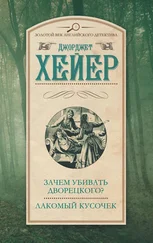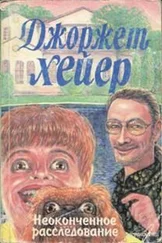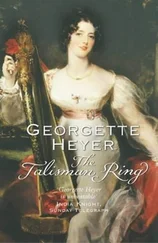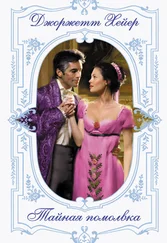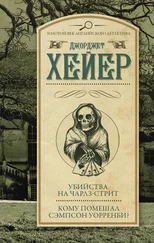Джорджетт Хейер - Penhallow
Здесь есть возможность читать онлайн «Джорджетт Хейер - Penhallow» весь текст электронной книги совершенно бесплатно (целиком полную версию без сокращений). В некоторых случаях можно слушать аудио, скачать через торрент в формате fb2 и присутствует краткое содержание. Год выпуска: 1942, Жанр: Детектив, на английском языке. Описание произведения, (предисловие) а так же отзывы посетителей доступны на портале библиотеки ЛибКат.
- Название:Penhallow
- Автор:
- Жанр:
- Год:1942
- ISBN:нет данных
- Рейтинг книги:3 / 5. Голосов: 1
-
Избранное:Добавить в избранное
- Отзывы:
-
Ваша оценка:
- 60
- 1
- 2
- 3
- 4
- 5
Penhallow: краткое содержание, описание и аннотация
Предлагаем к чтению аннотацию, описание, краткое содержание или предисловие (зависит от того, что написал сам автор книги «Penhallow»). Если вы не нашли необходимую информацию о книге — напишите в комментариях, мы постараемся отыскать её.
Penhallow — читать онлайн бесплатно полную книгу (весь текст) целиком
Ниже представлен текст книги, разбитый по страницам. Система сохранения места последней прочитанной страницы, позволяет с удобством читать онлайн бесплатно книгу «Penhallow», без необходимости каждый раз заново искать на чём Вы остановились. Поставьте закладку, и сможете в любой момент перейти на страницу, на которой закончили чтение.
Интервал:
Закладка:
She thought privately that a bout of indigestion served her husband right; and hoped that it might prevent his again demanding this objectionable dish.
As though he read this thought, Reuben said: “But no one won’t get him to believe it was the pie, tell him till Doomsday, set in his ways, that’s what he is.”
It seemed to her beneath her dignity to discuss her husband with his manservant, so she returned no answer, but laid the newspaper down on the table, and moved towards the corridor which ran along the back of the western end of the house.
A series of small windows, set deep in the stone wall, lit the corridor, which led past a winding staircase to a smaller hall with a door leading out of the back of the house into Clara’s fern-garden. Beyond this, double doors gave on to a room which seemed to have been designed as a ballroom, and which had been for several years Penhallow’s bedroom.
Faith hesitated for a moment, with her hand on the door, and her head slightly bent to catch any sound of voices within the room. She could hear nothing, and after drawing in her breath, rather in the manner of a diver about to plunge into deep waters, she turned the handle, and went in.
Chapter Three
The room into which Faith Penhallow stepped occupied the whole of the floor space at the western end of the house, and had windows at each end, those at the front looking out on to the sweep of the avenue leading down to the lodge-gates, and the lawn and fields beyond; and those at the back overlooking an enclosed garden, surrounded on three sides by a grey, creeper-hung wall. This wing of the house had been added to the original structure in the seventeenth century; Penhallow’s room was wainscoted from floor to ceiling, and contained, besides some magnificent mouldings, a superb fireplace on the wall between the double doors through which Faith had come, and another, single door leading into a dressing-room at the front of the house. This fireplace was most richly carved, its lofty mantelpiece upheld, on either side of the big square cavity where a log fire burned on a huge pile of woodash, by caryatids. The room was higher-pitched than the rooms in the main part of the house, and had a very fine plaster ceiling, somewhat damaged in places by cracks, and blackened by smoke, which would occasionally puff out from the hearth, when the wind was in the wrong quarter. The heavy wainscoting made the room dark, in spite of the windows at each end, but the first impression anyone entering it was of colour, so varied and unexpected as to make the uninitiated blink.
The room was crammed with furniture, and ornanments jostled one another on the mantelpiece, on the tops of several chests, over several small tables which had been fitted into any vacant space that offered. These, like the incredible assortment of furniture, seemed to have been chosen without regard to period or congruity, which was indeed the case, Penhallow having crammed into the room every piece that took his fancy. Thus, a red lacquer cabinet, with an ivory figure of the god Ho-Ti on the top of it, stood between the two windows at one end of the room, and two repulsive plant-holders, fashioned of bamboo and each containing some half-a-dozen pots of tropical greenery, stood under the corresponding windows at the other end of the room. Flanking the fireplace were two enormous malachite vases, on consoles, which had been wrested from the Yellow drawing-room. In one corner stood a marble-topped wash-stand of red mahogany, imperfectly hidden by a cheap Japanese screen which showed a covey of golden birds flying on a black ground. Close to this, on the wall opposite to the fireplace, was a marquetry chest, mellow with age, rubbing shoulders with a delicate table of yellow satinwood, squeezed between it and the bed. Beyond the bed, a walnut tallboy confronted a round table covered with a crimson chenille cloth, and a Carolinian day-bed of particularly graceful design, whose frayed cane seat and back were fitted with squabs of faded wine-red velvet. Penhallow’s wheeled chair stood in the corner, and a long refectory table, piled with books, papers, decanters, medicine-bottles, and a canvas-bag from which several dog-biscuits had spilled, occupied most of the space behind the front windows. A mahogany corner-cupboard hung beside the door into the dressing-room; several armchairs of varied design and colour were scattered about the room, together with a pair of rush-seated ladder-back chairs; an early Chippendale stool, with cabriole legs and claw-and-ball feet; an angular seat of Gothic design and unsurpassed discomfort; and a large chesterfield, which was drawn across the foot of the bed. There were no pictures on the walls, but a convex mirror of Queen Anne date, set in a gilded frame, hung over the mantelpiece, and there were a number of candle-sconces round the room. On the mantelpiece, a gilt time-piece with an enamelled face, and supported by nymphs and cherubim, stood under a glass dome, and was flanked by a pair of Rockingham pheasants, one or two pieces belonging to an old chess-set, and two groups of bronze horses. The corner by the double doors was taken up by a grandfather clock of Chippendale-chinois; and, placed wherever space could be found for them, were some small, spindle-legged tables, covered with punch-spoons, snuff boxes, patch-boxes, Bristol paper-weights, and Dresden figures.
But it was not the medley of ornaments, the crowded furniture, or the juxtaposition of wine-red and crimson and the hot scarlet of Chinese lacquer which instantly claimed and held the visitor’s attention. Colour rioted in the carpet which almost covered the floor, grass-green curtains swore at chairs upholstered in peacock-blue, but they all faded into neutrality beside the blaze of colour thrown over Penhallow’s bed in the form of a patchwork quilt sewn in multi-coloured hexagons of satin, velvet and brocade.
The bed itself dominated the room. It might have burn supposed that so massive and antiquated a structure had been in the family for generations: in actual fact Penhallow had bought it at a sale some years previously. It was an enormous four-poster of painted wood, hung about with curtains of mulberry velvet, much rubbed and faded with age, with a ceiling painted with a design of cupids and rose-garlands, and an intricate arrangement of cupboards and drawers set in the tall headpiece. It stood uncomfortably high, and was wide enough to have accommodated four people without undue crowding. In the middle of it, banked up by a selection of pillows and cushions, and wearing an ancient dressing-gown over his pyjamas, lay Penhallow, a mountainous ruin of a man, with a hawk-nose jutting between bloated cheeks; fierce, malicious eyes staring beneath brows that were still jet-black and bushy; and an arrogant, intemperate mouth. His hair was grizzled, and it could be seen that he had developed a huge paunch. Around him, spread over the splendour of the quilt, were a variety of books, periodicals, cigar-cases, match-boxes, ledgers, letters, and a dish piled with fruit. At the foot of the bed, panting slightly, lay an aged and rather smelly Cocker spaniel, as obese as her master. It was her amiable custom to growl at anyone entering Penhallow’s room, and she made no exception in Faith’s favour.
“Good bitch!” said Penhallow approvingly.
Faith shut the door behind her, and moved towards an armchair which stood at some distance from the fire.
The room was uncomfortably warm, the pile of woodash in the hearth glowing red under a couple of smouldering logs. Except during the very few weeks in the year when Penhallow allowed his fire to go out, the ash was never removed. It made the dusting of his bedroom one of the labours of Hercules, but that was a consideration which naturally did not weigh with him.
Читать дальшеИнтервал:
Закладка:
Похожие книги на «Penhallow»
Представляем Вашему вниманию похожие книги на «Penhallow» списком для выбора. Мы отобрали схожую по названию и смыслу литературу в надежде предоставить читателям больше вариантов отыскать новые, интересные, ещё непрочитанные произведения.
Обсуждение, отзывы о книге «Penhallow» и просто собственные мнения читателей. Оставьте ваши комментарии, напишите, что Вы думаете о произведении, его смысле или главных героях. Укажите что конкретно понравилось, а что нет, и почему Вы так считаете.



